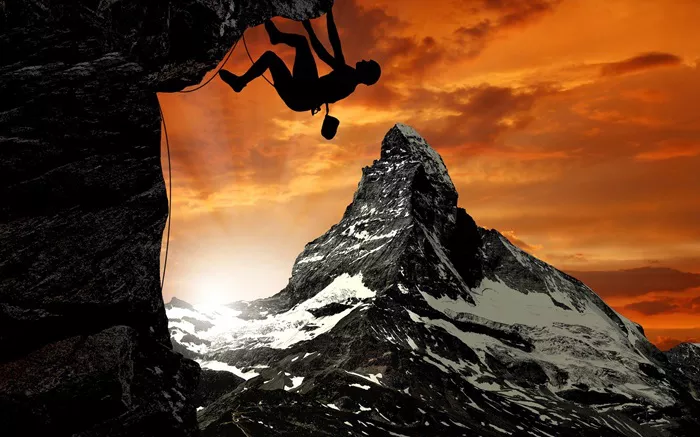Free rock climbing, often referred to simply as free climbing, is a style of climbing where climbers use only their physical strength and techniques to ascend a rock face, relying solely on natural features of the rock such as cracks, edges, and holds. Unlike aid climbing, which involves using gear to assist in upward progress, free climbing emphasizes the challenge and athleticism of ascending without artificial aids.
Understanding the Basics of Free Climbing
Essential Gear for Free Climbing
In free climbing, the gear primarily consists of safety equipment rather than aids for ascending. This section covers the necessary gear such as ropes, harnesses, helmets, and specialized climbing shoes that enhance grip and precision on rock surfaces.
Techniques and Movements in Free Climbing
This section explores the fundamental techniques employed in free climbing, including smearing, edging, stemming, and jamming. Techniques for maintaining balance, conserving energy, and executing efficient movements are crucial for success in free climbing.
Types of Free Climbing
Traditional (Trad) Climbing
Trad climbing involves placing and removing protection devices such as cams, nuts, and hexes into natural rock features as climbers ascend. This section delves into the skills required for gear placement, anchor building, and the ethics surrounding leaving no trace on natural rock formations.
Sport Climbing
Sport climbing focuses on ascending established routes equipped with fixed bolts for protection. This part covers the differences in gear and techniques compared to traditional climbing, including clipping methods, route reading, and the importance of understanding bolted anchors.
Bouldering
Bouldering is a form of free climbing that involves shorter routes, typically no higher than 20 feet (6 meters), without the use of ropes. This section discusses the dynamic movements, crash pads, and spotting techniques essential for safety in bouldering.
Advanced Techniques and Skills
Crack Climbing
Crack climbing is a specialized skill within free climbing that involves ascending long, narrow fissures in rock faces. This section explores the various types of cracks, such as finger cracks, hand cracks, and off-width cracks, along with the techniques required to navigate them effectively.
Overhangs and Steep Climbing
Climbing steep and overhanging rock presents unique challenges in free climbing. This part covers techniques like heel hooks, toe jams, and campus board training to build strength and agility for tackling steep terrain.
Multi-pitch Climbing
Multi-pitch climbing involves ascending routes that are longer than a single rope length, requiring climbers to belay each other at multiple stances or “pitches.” This section discusses the logistics, communication strategies, and gear management essential for safe and efficient multi-pitch climbs.
see also: When Is The Right Age To Start Rock Climbing?
Safety and Risk Management
Understanding Climbing Ratings and Grading Systems
Climbing routes are rated based on difficulty and danger. This section explains the different grading systems used worldwide, such as the Yosemite Decimal System (YDS) and the International French Adjectival System (IFAS), to assess the technical difficulty and seriousness of climbs.
Injury Prevention and Climbing Fitness
Maintaining physical fitness and preventing common climbing injuries are crucial for longevity in free climbing. This part covers warm-up routines, strength training exercises, and strategies for managing overuse injuries like tendonitis and finger strains.
Environmental Ethics and Leave No Trace Principles
Free climbing enthusiasts have a responsibility to minimize their impact on natural environments. This section explores the principles of Leave No Trace (LNT) and sustainable climbing practices, including proper waste disposal, respecting wildlife habitats, and minimizing chalk use.
Famous Free Climbing Destinations
Yosemite National Park, USA
Yosemite Valley is renowned for its iconic granite walls and classic free climbing routes like El Capitan and Half Dome. This section highlights the history of free climbing in Yosemite and the allure of its challenging and scenic climbs.
Kalymnos, Greece
Kalymnos has emerged as a premier sport climbing destination, featuring limestone cliffs and a Mediterranean climate ideal for year-round climbing. This part explores the development of sport climbing in Kalymnos and its vibrant climbing community.
Fontainebleau, France
Fontainebleau’s expansive forest and sandstone boulders make it a mecca for bouldering enthusiasts. This section discusses the history of bouldering in Fontainebleau and the unique characteristics of its renowned circuits and problems.
Conclusion
Embracing the Spirit of Free Climbing
Free climbing embodies the essence of adventure, athleticism, and connection with nature. Whether scaling towering granite walls or navigating intricate boulder problems, the challenges and rewards of free climbing inspire climbers worldwide to push their limits and explore new heights.


